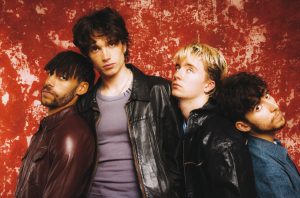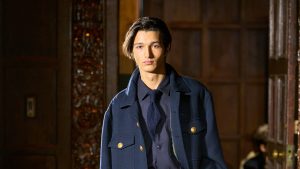
PARIS — In today’s world of fiction, people play characters more than ever, adopting new personas daily. And fashion is happy to play along, offering not just clothes and accessories, but the possibility to be whoever you want to be. The Paris men’s fashion week that closed on Sunday served up an array of masculine personas: at times, it worked; at times, it looked like cosplay.
There was a heavy sense of cosplay at Willy Chavarria’s highly anticipated but ultimately discombobulating Paris debut. Taking over the American Church on Avenue George V with his Latino and Chicano posse of cowboys, church boys, gym boys and vamps in their Sunday best, Chavarria, one of the most lauded voices to have emerged from New York in recent years, bravely tried to raise the game, but what he delivered felt costumey, devoid of sensuality and needlessly loud. (His work feels deeply indebted to Miguel Androver, but lacks the gritty soulfulness and executional finesse Miguel had).
Pharrell’s joint effort with Nigo at Louis Vuitton felt similarly soulless: deluxe hip-hop wear for the wealthy — another form of cosplay, if you like — inspired by the dialogue between the two, and based on the way they both dress. The personal dimension, which in theory could have brought an air of authenticity to the proceedings, was instead the thin narrative thread of an exercise in luxury merchandising that felt rather crude. Several seasons into his tenure, Pharrell remains on repeat, while one would like to see him freely experiment with fashion as much as he does with music.
Junya Watanabe’s bearded hipsters came a few years too late, seeming out of place in the ever-progressive world of Comme des Garçons. The 1970s lounge lizard feel at Amiri verged on the costume-y at times, but there seemed to be pure intent behind Mike Amiri’s unwavering will to keep evolving, establishing a reputation in tailoring while allowing the label to grow up.
Doublet’s Masayuki Ino keeps operating in an orbit all his own. Following him as he evolves the narrative of his ramshackle, lyrical brand is an entertaining and thought-provoking exercise. This season, Ino went for villains — the bad guys from movies or books; the punks, goths and other outcast losers who don’t align with wider society’s sense of righteousness — and scored.
The theatre over at Dior was abstract and solemn, a fashion mix of Bib Wilson and Peter Greenaway. To the highly emotional and repetitive sound of Michael Nyman’s “McQueen: Timelapse,” designer Kim Jones released what looked like a farewell collection — an impression heightened by his embrace of Delphine Arnault — that despite the profusion of mourning black made for his best and probably his lightest outing in his seven years at the house: an exploration of metamorphosis rooted in Monsieur Dior’s 1954 H line collection. Technically, it was masterful, but as ever at Jones’ Dior, the results felt a little chilly and clinical despite the brooding romanticism.
Romanticism was the thing at Dries Van Noten, too, where new creative director Julian Klausner’s debut came in the form of a showroom presentation, not a runway show. (The collection was actually designed by the studio team and completed by him). It was an interesting take on the Dries code, at once languid and sensual, that was condensed in beautifully made, intricate pieces to which the Willy Vanderperre-shot lookbook did little justice, making them look referential and fey. No matter, Klausner’s captivating sensibility came across.
Now, for some realism. A tranche de vie sensibility has been part of the Lemaire ethos since day one. Christophe Lemaire and Sarah-Linh Tran have mastered the art of creating collections that seem to have already been lived in when they hit the catwalk, avoiding affectation and theatrics. The addition of considered urban toughness, this season, was particularly on point.
Real clothes for real life is the focus of Auralee’s Riota Iwai, one of Paris’ most interesting new voices. Iwai delivers clothing that, by fashion standards, appears to be very normal. But closer inspection reveals nothing normal about his work: the colours and proportions are off; the texture too; and the overall effect is slightly off-kilter and eminently subtle. His latest collection had a harder edge, and it was smashing. Ami’s Alexandre Mattiussi is another realist, in intention, but the more the brand grows, the more his output becomes more sophisticated and idealised, but also detached from reality. Amidst the slouchy pantsuits, liquid shirts, trouser-skirts and the general sense of fluid elegance, what came to the fore this season was beautiful clothes on supermodels. A bit less gloss, a touch of imperfection could make things more lively. At Wales Bonner, which this season was presented with a lookbook, there was a newfound pragmatism to the namesake designer’s exquisite touch. Informed by artist Theaster Gate and his personal style, she explored a sharper edge full of potential and elegance.
Workwear, Parisian chic and nods to Kimono dressing coalesced in a painterly way at Kenzo, where Nigo finally found his stride, thanks not least to the arrival of design director Joshua Bullen. Within this context, even the collaboration with legendary graffiti artist Futura felt organic. Truth be told, Kenzo is still a dormant beauty with an underwhelming reach, but an awakening may have just begun.
The French Touch agenda was particularly high this season, halfway between cliché and a sense of proud Gallic masculinity. Forever inspired by his own life on the Left Bank, Officine Générale’s Pierre Maheo has always been so inclined: this season his intimate show, held at Café La Rouquet, was a charming iteration of the formula. Over at Fursac, Gauthier Borsarello continues to take strides as he revamps the brand, delivering an insouciant gang of wild boys in shrunken jumpers and short ties that had tons of charm and energy. Paul Smith, meanwhile, reaffirmed its dedication to Brit classicism with a twist.
Unsurprisingly, given the times, a streak of distorted militarism ran through the collections. The peaceniks over at Comme des Garçons were all about silent yet visually impactful protest in their flowery helmets and olive drab going this way and that. This made for a collection that although quite literal, was one of the best from Rei Kawakubo in ages. At Juun J, militaria was just an echo captured in the humongous shapes and multiplication of pockets, while Louis Gabriel Nouchi offset the control of military uniforms with the liberating powers of sensuality and skin in a very personal collection inspired by George Orwell’s 1984. Despite the effort, it did not quite glue — translating such a prescient novella into clothing is not an easy task — not least because the cast of characters on the catwalk, despite the welcome diversity, was not as strong as in previous Nouchi efforts. At Kiko Kostadinov, the lab-like chill, which to this writer recalls 1970s science fiction flicks from the Eastern Bloc, gave way to a more rustic and organic feel, and that resulted in a kind of icy lightness that was beguiling.
The beauty of Paris is still in the variety of voices who present undiluted visions here. Yohji Yamamoto’s take on menswear never ceases to amaze for its roughness, poetry and ability to embrace men of all ages and body types. This season, starting with the duvet, Yohji-san focused on the idea of padding, which he extended to a whole multipurpose wardrobe, trousers included. The result was a Michelin man of sorts: softly quilted to absorb the hardness of life, and poetic to the nth degree.
Issey Miyake’s IM Men, a project launched by Issey-san in 2021, made a smashing catwalk debut, delivering a floating vision of contemporary nomadism that was abstract in the emotional purity of the lines, and pragmatic in the absolute practicality of clothes that can be easily folded and flattened.
After last season’s colossal production, Rick Owens opted for reduction and introspection. He entitled the collection “Concordians” after the tiny and industrious Emilian village of Concordia Sulla Secchia, where Owenscorp is based, and explored the almost monastic dedication of the days he spends in Italy working on the garments with the team, searching for something weird and wonderful. This translated into a tight edit of garments — the long johns and the duffle coat, the leather jacket, the trench coat, the flared jeans and the platforms — held together not so much by a narrative intent, but by a sense of affection. The nuda veritas effect highlighted the intrinsic classicism of a designer who isn’t classic at all.
Elsewhere, it was all about beautiful and desirable clothes, no intellectual explanation needed. At Hermès, Véronique Nichanian was in a state of grace. Working to a graphic and pointy agenda, yet staying true to the roots of the brand and its savoir faire, she delivered a tense, snappy collection that was rooted in the moment and fresh. Marching to his own drum in his own bubble, Hed Mayner is an influential author who does not claim global prominence nor worldwide notoriety, only a space to have his say. He continues to work on gigantic volumes, which this time he bent and shaped by way of collapsing lines, martial cuts, repurposing and wild textures, and it was enchanting.
The meeting between Yohji Yamamoto and Adidas over at Y-3 continues to bear fruit, in a convergence of athleticism and deconstruction. At Kolor, everything was light, swirling with delicate tones, multiplied details and hybrid shapes, but the atmosphere was melancholic. With a concise but soulful letter handed to guests as they entered the venue, founder Junichi Abe announced this to be his last effort, after which he will take on the role of president, entrusting design to someone new. Such a conscious choice, at the age of 60, felt as poetic as the clothes for which Abe, in twenty years of Kolor, has gathered loyal customers, followers of his unique sense of form and colour, and his graceful way of being experimental.
In today’s fashion world, formulas abound: they are a way to reiterate a code, especially when it is successful. Formulaic, however, does not always mean schematic. This is the case with Sacai, whose show was yet another affirmation of Chitose Abe’s distinctive language. The designer has always worked on the idea of hybridity, and of volumes that are informed by movement. This season she took the conversation to a mountainous, wild setting — “Where The Wild Things Are” read a T-shirt, and in fact the atmosphere of the entire show swung between the primitive and the dreamlike, as in the illustrated story by Maurice Sendak, coming across as free and energetic.
Back on the Paris calendar, Simone Porte Jacquemus twisted his own formula, rescaling his show from grand destination to intimate salon, taking over the beautiful Auguste Perret apartment in the 16th arrondissement, while elevating the offer with a mock couture feel. Suffused with 1950s optimism, the collection aimed at showcasing maturity and class, but the balloon backs and fluted skirts failed to deliver. Clean and streamlined, with a nipped waist, the menswear was better than the women’s. And yet… brand elevation requires faultless execution, otherwise it’s no more than theory.
The week of character building ended with a cast of “modern characters” at Peter Coppings’ debut for Lanvin. Modern as in bony-faced and glowing in their raw, make-up free beauty, and in their mix of feminine and masculine dressing with a decisive 1930s feel. Back in the day, Art Deco was ultra-modern, and that mark stayed somehow through the decades. In an attempt to revive a house that is in dire need of revival, Copping, who is a revered industry veteran, tried to reconnect with the seminal work, and spirit, of founder Jeanne Lanvin in the 1930s, throwing in a bit of longtime designer Alber Elbaz.
The results were mixed, with the womenswear looking a bit too eclectic. The menswear was more in focus: soulfully sleek and elegant, much in a Stefano Pilati kind of vein. But one was left wondering: why do we need this proposition? The 1930s, by now, are vintage modern, even if they made for a good starting point. As for the characters on the catwalk, variety is key, which is what fashion’s obsession with personas currently lacks. The offer, though wide, was overly codified, which made it feel narrow.








